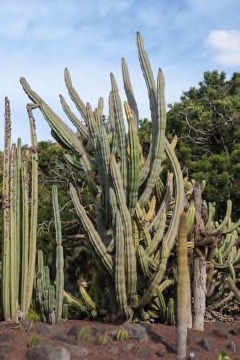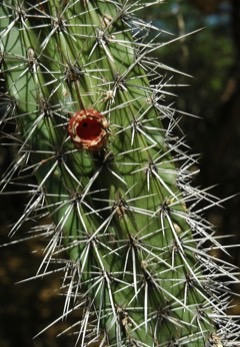 |
|
Wikimedia.org - Llez |
 |
| William M. Ciesla, Forest Health Management International, Bugwood.org |
Translate this page:
Summary
Physical Characteristics

 Stenocereus griseus is an evergreen Tree growing to 7 m (23ft) by 3 m (9ft) at a medium rate.
Stenocereus griseus is an evergreen Tree growing to 7 m (23ft) by 3 m (9ft) at a medium rate.
See above for USDA hardiness. It is hardy to UK zone 10. The flowers are pollinated by Bats.
It is noted for attracting wildlife.
Suitable for: light (sandy) and medium (loamy) soils, prefers well-drained soil and can grow in nutritionally poor soil. Suitable pH: neutral and basic (mildly alkaline) soils and can grow in very alkaline soils.
It cannot grow in the shade. It prefers dry soil and can tolerate drought.
UK Hardiness Map
US Hardiness Map
Synonyms
Cereus clavatus Otto & A. Dietr. Cereus deficiens Otto & A. Dietr. Cereus eburneus Salm-Dyck Cereus griseus Haw. Lemaireocereus deficiens (Otto & A. Dietr.) Britton & Rose Lemaireocereus griseus (Haw.) Britton & Rose Ritterocereus deficiens (Otto & A. Dietr.) Backeb. Ritterocereus griseus (Haw.) Backeb. Stenocereus deficiens (Otto & A. Dietr.) Buxb.
Plant Habitats
Edible Uses
Edible Parts: Fruit
Edible Uses: Drink
The fruits are edible and have a good taste[317 ]. A delicious flavour[46 ]. The fruits are around 5cm in diameter, spiny when immature[200 ]. Immature fruits have spines on them, but these are lost as the fruit ripens[423 ]. The pulp has the potential to be used in the production of wine and marmalade (J. Nassar pers. comm. 2011).
References More on Edible Uses
Medicinal Uses
Plants For A Future can not take any responsibility for any adverse effects from the use of plants. Always seek advice from a professional before using a plant medicinally.
None known
References More on Medicinal Uses
The Bookshop: Edible Plant Books
Our Latest books on Perennial Plants For Food Forests and Permaculture Gardens in paperback or digital formats.

Edible Tropical Plants
Food Forest Plants for Hotter Conditions: 250+ Plants For Tropical Food Forests & Permaculture Gardens.
More

Edible Temperate Plants
Plants for Your Food Forest: 500 Plants for Temperate Food Forests & Permaculture Gardens.
More

More Books
PFAF have eight books available in paperback and digital formats. Browse the shop for more information.
Shop Now
Other Uses
References More on Other Uses
Cultivation details
Agroforestry Services: Living fence Management: Standard Regional Crop
A plant of drier areas in the tropics and subtropics. Plants can only tolerate the lightest of frosts. Requires a sunny position and a well-drained soil[200 ]. Prefers a pH in the range 6 - 7.5[200 ]. Established plants are very drought tolerant[46 ]. The plant is subspontaneous and spontaneous after abandoned cultivation[317 ]. Grows in huge numbers in the dryer zones of the Caribbean Rim, where plants may reach 10 m in height and grow in dense thickets. It is so common as nearly to be a weed in the desert scrub of Aruba, Bonaire, and Curacao of the Netherlands Antilles, where it grows both wild and cultivated. The plants are also commonly planted around homes and gardens and are tolerated on agricultural lands, meaning that plants are left when the vegetation is cleared for agriculture.
Carbon Farming
-
Agroforestry Services: Living fence
Simply managed rows of shrubs and trees.
-
Management: Standard
Plants grow to their standard height. Harvest fruit, seeds, or other products. Non-Destructive management systems.
-
Regional Crop
These crops have been domesticated and cultivated regionally but have not been adopted elsewhere and are typically not traded globally, Examples in this broad category include perennial cottons and many nuts and staple fruits.
References Carbon Farming Information and Carbon Sequestration Information
Temperature Converter
Type a value in the Celsius field to convert the value to Fahrenheit:
Fahrenheit:
The PFAF Bookshop
Plants For A Future have a number of books available in paperback and digital form. Book titles include Edible Plants, Edible Perennials, Edible Trees,Edible Shrubs, Woodland Gardening, and Temperate Food Forest Plants. Our new book is Food Forest Plants For Hotter Conditions (Tropical and Sub-Tropical).
Shop Now
Plant Propagation
Seed - Cuttings
Other Names
If available other names are mentioned here
Pitayo de mayo, Mexican organpipe cactus, Dagger cactus, Pitaya,
Native Range
SOUTHERN AMERICA: Trinidad and Tobago, Venezuela, Colombia,
Weed Potential
Right plant wrong place. We are currently updating this section.
Please note that a plant may be invasive in one area but may not in your area so it's worth checking.
None Known
Conservation Status
IUCN Red List of Threatened Plants Status : Status: Least Concern

Growth: S = slow M = medium F = fast. Soil: L = light (sandy) M = medium H = heavy (clay). pH: A = acid N = neutral B = basic (alkaline). Shade: F = full shade S = semi-shade N = no shade. Moisture: D = dry M = Moist We = wet Wa = water.
Now available:
Food Forest Plants for Mediterranean Conditions
350+ Perennial Plants For Mediterranean and Drier Food Forests and Permaculture Gardens.
[Paperback and eBook]
This is the third in Plants For A Future's series of plant guides for food forests tailored to
specific climate zones. Following volumes on temperate and tropical ecosystems, this book focuses
on species suited to Mediterranean conditions—regions with hot, dry summers and cool, wet winters,
often facing the added challenge of climate change.
Read More
Expert comment
Author
(Haw.) Buxb.
Botanical References
Links / References
For a list of references used on this page please go here
A special thanks to Ken Fern for some of the information used on this page.
Readers comment
| Add a comment |
|
If you have important information about this plant that may help other users please add a comment or link below. Only comments or links that are felt to be directly relevant to a plant will be included. If you think a comment/link or information contained on this page is inaccurate or misleading we would welcome your feedback at [email protected]. If you have questions about a plant please use the Forum on this website as we do not have the resources to answer questions ourselves.
* Please note: the comments by website users are not necessarily those held by PFAF and may give misleading or inaccurate information.
To leave a comment please Register or login here All comments need to be approved so will not appear immediately.
|
Subject : Stenocereus griseus
|
|
|
|